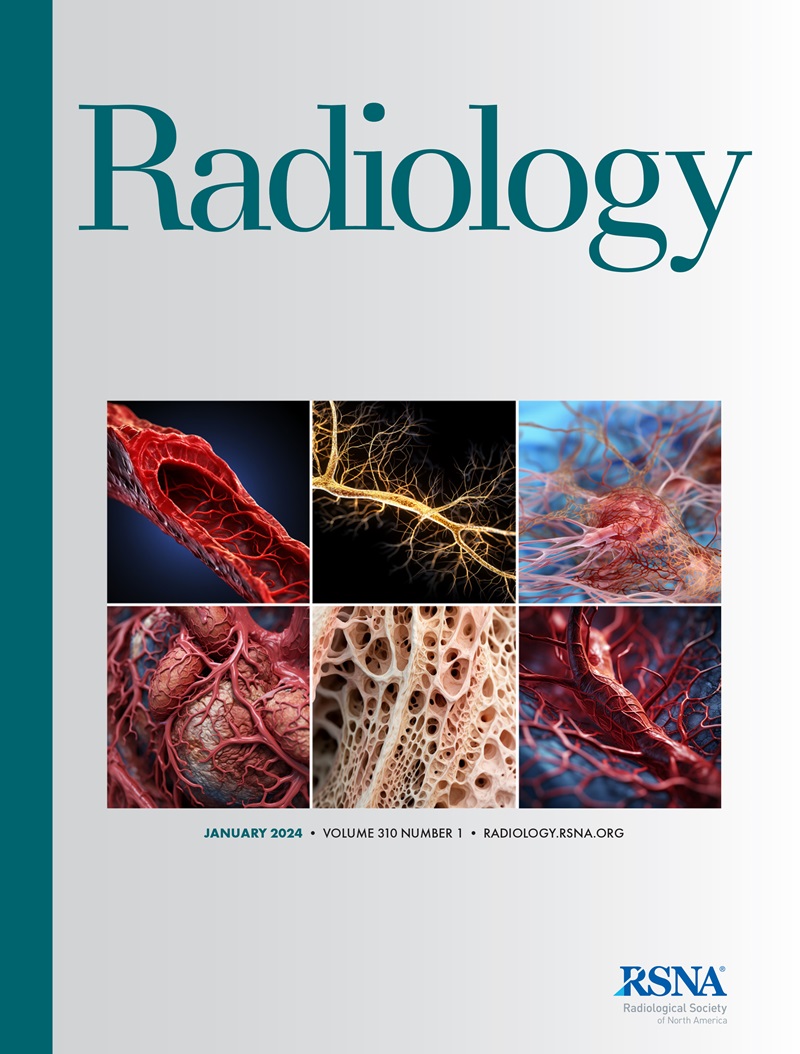Diagnostic Value of Swallow Tail Sign at Brain MRI in Patients with Clinically Uncertain Parkinsonian Syndrome.
IF 15.2
1区 医学
Q1 RADIOLOGY, NUCLEAR MEDICINE & MEDICAL IMAGING
引用次数: 0
Abstract
Background Striatal dopaminergic deficits, established with iodine 123-2β-carbomethoxy-3β-(4-iodophenyl)-N-(3-fluoropropyl)-nortropan (123I-FP-CIT) SPECT, support the diagnosis of Parkinson disease (PD) or atypical parkinsonian syndrome in clinical uncertainty. The swallow tail sign (STS) at susceptibility-weighted (SW) MRI helps differentiate patients with PD from controls, but its utility in clinically uncertain parkinsonian syndromes remains unclear. Purpose To compare the diagnostic performance of STS absence at SW MRI in diagnosing PD with that of 123I-FP-CIT SPECT in participants with clinically uncertain parkinsonian syndrome. Materials and Methods This prospective, multicenter study included participants with clinically uncertain parkinsonian syndrome between May 2016 and May 2019. Imaging modality specialists independently assessed images from SW MRI and 123I-FP-CIT SPECT while blinded to clinical findings. Diagnostic performance was assessed against diagnosis at clinical follow-up as the reference standard. Performance metrics were compared between modalities and post hoc subgroups split by diagnostic confidence and motor severity using Z tests. Cohen κ was computed for intrarater, interrater, and intermodality reliability. Results A total of 106 participants with clinically uncertain parkinsonian syndrome and diagnostic 3-T SW MRI examinations were included in the study sample (median age, 69 years [IQR, 14 years]; 59 male). STS assessment showed substantial agreement within (κ = 0.69; 95% CI: 0.55, 0.83) and between (κ = 0.70; 95% CI: 0.56, 0.84) raters. STS absence demonstrated a sensitivity of 81% (95% CI: 70, 90) and specificity of 75% (95% CI: 58, 88) in predicting PD. Post hoc analysis demonstrated better diagnostic performance in the subgroup with high (60 of 106 participants) versus low diagnostic confidence, with 91% sensitivity (95% CI: 79, 98; Z = 2.8; P = .005), 87% specificity (95% CI: 60, 98; Z = 1.4; P = .17), and 90% accuracy (95% CI: 79, 96; Z = 3.1; P = .002). 123I-FP-CIT SPECT yielded higher sensitivity than STS (98% [95% CI: 91, 100]; Z = 3.3; P = .001) but only 55% specificity (95% CI: 39, 70; Z = -1.9; P = .06). Conclusion In participants with clinically uncertain parkinsonian syndrome, STS absence on 3-T brain SW MRI scans supported the diagnosis of PD with high accuracy overall and greater accuracy when the diagnostic confidence of STS assessment was high. Clinical trial registration no. NCT03022357 © RSNA, 2025 Supplemental material is available for this article.脑MRI燕子尾征对临床不确定帕金森综合征的诊断价值。
背景:碘123-2β-碳甲氧基-3β-(4-碘苯基)-n -(3-氟丙基)-nortropan (123I-FP-CIT) SPECT建立纹状体多巴胺能缺陷,支持帕金森病(PD)或非典型帕金森综合征的临床不确定性诊断。敏感性加权(SW) MRI的燕子尾征(STS)有助于区分PD患者和对照组,但其在临床上不确定的帕金森综合征中的应用尚不清楚。目的比较SW MRI STS缺失与123I-FP-CIT SPECT对临床不确定帕金森综合征患者PD诊断的价值。该前瞻性多中心研究纳入了2016年5月至2019年5月期间临床不确定帕金森综合征的参与者。成像模式专家独立评估来自SW MRI和123I-FP-CIT SPECT的图像,对临床结果不知情。诊断表现以临床随访诊断作为参考标准。使用Z测试,通过诊断置信度和运动严重程度来划分模式和事后亚组之间的性能指标进行比较。计算了通道内、通道间和通道间信度的Cohen κ。结果共纳入106例临床不确定帕金森综合征和诊断性3-T SW MRI检查的参与者(中位年龄69岁[IQR, 14岁];59岁男性)。STS评估结果在(κ = 0.69;95% CI: 0.55, 0.83)和之间(κ = 0.70;95% CI: 0.56, 0.84)。STS缺失预测PD的敏感性为81% (95% CI: 70, 90),特异性为75% (95% CI: 58, 88)。事后分析显示,诊断置信度高的亚组(106名参与者中的60名)比诊断置信度低的亚组诊断效果更好,灵敏度为91% (95% CI: 79,98;Z = 2.8;P = 0.005), 87%特异性(95% CI: 60, 98;Z = 1.4;P = 0.17),准确率为90% (95% CI: 79,96;Z = 3.1;P = .002)。123I-FP-CIT SPECT的灵敏度高于STS (98% [95% CI: 91, 100];Z = 3.3;P = .001),但只有55%的特异性(95% CI: 39,70;Z = -1.9;P = .06)。结论在临床上不确定帕金森综合征的受试者中,3-T脑SW MRI扫描STS缺失总体上支持PD的诊断准确性较高,当STS评估的诊断置信度高时准确性更高。临床试验注册号:NCT03022357©RSNA, 2025本文提供补充材料。
本文章由计算机程序翻译,如有差异,请以英文原文为准。
求助全文
约1分钟内获得全文
求助全文
来源期刊

Radiology
医学-核医学
CiteScore
35.20
自引率
3.00%
发文量
596
审稿时长
3.6 months
期刊介绍:
Published regularly since 1923 by the Radiological Society of North America (RSNA), Radiology has long been recognized as the authoritative reference for the most current, clinically relevant and highest quality research in the field of radiology. Each month the journal publishes approximately 240 pages of peer-reviewed original research, authoritative reviews, well-balanced commentary on significant articles, and expert opinion on new techniques and technologies.
Radiology publishes cutting edge and impactful imaging research articles in radiology and medical imaging in order to help improve human health.
 求助内容:
求助内容: 应助结果提醒方式:
应助结果提醒方式:


